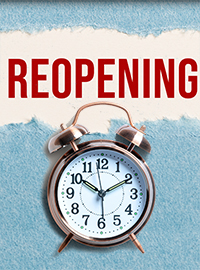| Time to Reopen the Economy |
 |
|
By Betsy McCaughey
Wednesday, June 24 2020 |
Mainstream media are sounding the alarm about the coronavirus cases spiking across the South and West. They're exaggerating the peril and trying to pin the blame on Republican governors and President Trump for reopening the economy too soon. No surprise, Governor Andrew Cuomo is piling on, accusing states of playing politics instead of opening "intelligently." Sorry, but there was nothing intelligent about how the Cuomo administration handled the pandemic. Metropolitan New York has had the highest number of deaths from the coronavirus of any place in the U.S. That's partly because New Yorkers who caught the virus had a far worse chance of surviving than infected patients in almost any other state. New York ranks a dismal 48 out of 50 in survival rates. Serious questions need to be raised about New York's poor performance. In spite of these damning facts, Cuomo is bragging about his results and bashing the Trump administration for encouraging states to reopen. Cuomo's wrong. The nation's doing pretty well. The United States reported 308 COVID deaths on Monday, down nearly 90% from the peak. In some states, including Maine, Louisiana, Florida and Texas, the number of cases is rising – partly because people are interacting again and partly because of increased testing. But new cases are overwhelmingly young people, who are unlikely to become seriously ill or die from the virus. In Florida, the median age of infected people plunged from 65 years old in March to 35 years old last week. In Texas, too, infections are hitting the young. Nationwide, cases are up but deaths are not. Former FDA Commissioner chief Scott Gottlieb warns that young people can bring the infection home to the elderly. The sensible approach is to take extra precautions to protect the elderly and health challenged, not shut down the economy. Caution is called for, but the media are determined to arouse panic. NPR's headline on Monday warned that "California Hits New High in COVID-19 Hospitalizations." The truth is Governor Gavin Newsom reported a slight uptick in the infection rate, from 4.5% of those tested to 4.8%, but still well below the 8% benchmark that he'd consider worrisome. Hospitalizations increased, but Newsom said hospital capacity remains "stable" and the state "is much better than where we were months ago." That's true across the nation. Hospitals are ready for an influx of patients, and medical professionals know more. They've learned the deadly risks of overusing ventilators and the advantages of positioning patients on their stomach to breathe. They also have at least one medication, Remdesivir, to lessen the disease's severity. The shutdown was a frantic response to the pandemic's suddenness. It bought time to increase hospital readiness. But at a terrible price. In retrospect, rushing resources to nursing homes, where half the deaths occurred and encouraging mask wearing could have saved as many lives as the shutdown without the economic toll. Masks are essential. Even Texas Governor Greg Abbott has come around, as cases and hospitalizations in his state reach what he calls "unacceptable" levels. A face covering prevents the aerosol droplets you emit when you talk or cough from reaching everyone else. Mayor Bill De Blasio's signature look, the bandana, protects those around him. But don't rely on that fashion statement if you also want to protect yourself. A cotton bandana is only 2% to 3% effective in blocking incoming viral droplets. A flat surgical mask, made from nonwoven polypropylene, blocks out about 56% of viral droplets, according to the British Medical Journal. The molded N95 mask, which is hard to get, filters out 95% of viral particles. Contaminated surfaces can spread the virus. New research confirms the virus spreads on objects. In hospitals, it's carried on stethoscopes, thermometers and blood pressure cuffs. In daily life, that means it can spread on elevator buttons, doorknobs and keyboards. Disinfect your hands and the objects you touch frequently. Employers should consider antimicrobial keyboards, desktops and coatings. Facts like these, not media hype, will keep us safe. Betsy McCaughey is chairman of the Committee to Reduce Infection Deaths and a former lieutenant governor of New York. |
Related Articles : |
























